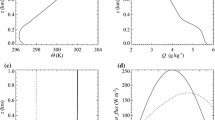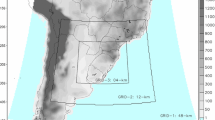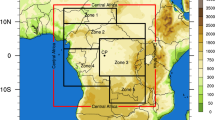Abstract
The study was aimed at understanding the deficiencies of numerical mesoscale models by comparing predictions with a new high-resolution meteorological dataset collected during the Mountain Terrain Atmospheric Modelling and Observations (MATERHORN) Program. The simulations focussed on the stable boundary layer (SBL), the predictions of which continue to be challenging. High resolution numerical simulations (0.5-km horizontal grid size) were conducted to investigate the efficacy of six planetary boundary-layer (PBL) parametrizations available in the advanced research version of the Weather Research and Forecasting model. One of the commonly used PBL schemes was modified to include eddy diffusivities that account for enhanced momentum transport compared to heat transport in the SBL, representing internal wave dynamics. All of the tested PBL schemes, including the modified scheme, showed a positive surface temperature bias. None of the PBL schemes was found to be superior in predicting the vertical wind and temperature profiles over the lowest 500 m, however two of the schemes appeared superior in capturing the lower PBL structure. The lowest model layers appear to have a significant impact on the predictions aloft. Regions of sporadic flow interactions delineated by the MATERHORN observations were poorly predicted, given such interactions are not represented in typical PBL schemes.











Similar content being viewed by others
References
Alapaty K, Pleim JE, Niyogi SR, Niyogi DS, Byun DW (1997) Simulation of atmospheric boundary layer processes using local and nonlocal-closure schemes. J Appl Meteorol 36:214–233
Argüeso D, Hidalgo-Mûnoz J, Gámiz-Fortis S, Esteban-Parra MJ, Dudhia J, Castro-Díez Y (2011) Evaluation of WRF parametrizations for climate studies over southern Spain using a multi-step regionalization. J Clim 24:5633–5651
Awan N, Truhetz H, Gobiet A (2011) Parametrization induced error characteristics of MM5 and WRF operated in climate mode over the Alpine region: an ensemble based analysis. J Clim 24(12):3107–3123
Borge R, Alexandrov V, del Vas JJ, Lumbreras J, Rodriguez E (2008) A comprehensive sensitivity analysis of the WRF model for air quality applications over the Iberian Peninsula. Atmos Environ 42:8560–8574
Bougeault P, Lacarrere P (1989) Parametrization of orography-Induced turbulence in a mesobeta-scale model. Mon Weather Rev 117(8):1872–1890
Braun S, Tao W (2000) Sensitivity of high-resolution simulations of hurricane Bob (1991) to planetary boundary layer parametrizations. Mon Weather Rev 128(12):3941–3961
Bright DR, Mullen SL (2002) The sensitivity of the numerical simulation of the southwest monsoon boundary layer to the choice of PBL turbulence parametrization in MM5. Weather Forecast 17(1):99–114
Chen F, Dudhia J (2001) Coupling an advanced land surface-hydrology model with the Penn State-NCAR MM5 modelling system. Part I: model implementation and sensitivity. Mon Weather Rev 129:569–585
Deng A, Stauffer D (2006) On improving 4-km mesoscale model simulations. J Appl Meteorol 45(3):361–381
Doran JC, Fast JD, Horel J (2002) The VTMX 2000 campaign. Bull Am Meteorol Soc 83(4):537–551
Dudhia J (1989) Numerical study of convection observed during the winter monsoon experiment using a mesoscale two-dimensional model. J Atmos Sci 46:3077–3107
Evans J, Ekström M, Ji F (2011) Evaluating the performance of a WRF physics ensemble over south-east Australia. Climat Dyn 39:1241–1258
Fernández J, Montávez J, Sáenz J, González-Rouco J, Zorita E (2007) Sensitivity of the MM5 mesoscale model to physical parametrizations for regional climate studies: annual cycle. J Geophys Res 112(D04101) doi:10.1029/2005JD006649
Fernando HJS (2003) Turbulence patches in a stratified shear flow. Phys Fluids 15(10):3164–3169
Fernando HJS, Weil JC (2010) Whither the stable boundary layer? A shift in the research agenda. Bull Am Meteorol Soc 91(11):1475–1484
Fernando HJS, Pardyjak ER (2013) Field studies delve into the intricacies of mountain weather. EOS 94(36):313–315
Fernando HJS, Pardyjak ER, Di Sabatino S, Chow FK, DeWekker SFJ, Hoch SW, Hacker J, Pace JC, Pratt T, Pu Z, Steenburgh JW, Whiteman CD, Wang Y, Zajic D, Balsley B, Dimitrova R, Emmitt GD, Higgins CW, Hunt JCR, Knievel JG, Lawrence D, Liu Y, Nadeau DF, Kit E, Blomquist BW, Conry P, Coppersmith RS, Creegan E, Felton M, Grachev A, Gunawardena N, Hang C, Hocut CM, Huynh G, Jeglum ME, Jensen D, Kulandaivelu V, Lehner M, Leo LS, Liberzon D, Massey JD, McEnerney K, Pal S, Price T, Sghiatti M, Silver Z, Thompson M, Zhang H, Zsedrovits T (2015) The MATERHORN—unraveling the intricacies of mountain weather. BAMS http://journals.ametsoc.org/doi/pdf/10.1175/BAMS-D-13-00131.1 (early online release)
Flaounas E, Bastin S, Janicot S (2011) Regional climate modelling of the 2006 west african monsoon: sensitivity to convection and planetary boundary layer parameterisation using wrf. Climat Dyn 36(5):1083–1105
Fry J, Xian G, Jin S, Dewitz J, Homer C, Yang L, Barnes C, Herold N, Wickham J (2011) Completion of the 2006 national land cover database for the conterminous United States. Photogramm Eng Remote Sens 77:858–864
Garcıa-Díez M, Fernandez J, Fita L, Yague C (2013) Seasonal dependence of WRF model biases and sensitivity to PBL schemes over Europe. Q J R Meteorol Soc 139(671):501–514
Grachev A, Leo LS, Di Sabatino S, Fernando HJS, Pardyjak E, Fairall CW (2015) Structure of turbulence in katabatic flows below and above the wind-speed maximum. Boundary-Layer Meteorol. doi:10.1007/s10546-015-0034-8 (early online release)
Grell GA, Dudhia J, Stauffer DR (1994) A description of the fifth-generation Penn State/NCAR mesoscale model (MM5), NCAR Technical Note: NCAR/TN-398+STR
Grisogono B, Oerlemans J (2001a) Katabatic flow: analytic solution for gradually varying eddy diffusivities. J Atmos Sci 58:3349–3354
Grisogono B, Oerlemans J (2001b) A theory for the estimation of surface fluxes in simple katabatic flows. Q J R Meteorol Soc 127:2725–2739
Hong SY, Pan HL (1996) Nonlocal boundary layer vertical diffusion in a medium-range Forecast model. Mon Weather Rev 124(10):2322–2339
Hong S, Noh Y, Dudhia J (2006) A new vertical diffusion package with an explicit treatment of entrainment processes. Mon Weather Rev 134(9):2318–2341
Hu XM, Nielsen-Gammon JW, Zhang F (2010) Evaluation of three planetary boundary layer schemes in the WRF model. J Appl Meteorol Climatol 49:1831–1844
Hunt JCR (1985) Diffusion in the stably stratified atmospheric boundary layer. J Clim Appl Meteorol 24:1187–1195
Janjic Z (1990) The step-mountain coordinate: physics package. Mon Weather Rev 118:1429–1443
Janjic ZI (1994) The step-mountain eta coordinate model: further development of the convection, viscous sublayer, and turbulence closure schemes. Mon Weather Rev 122:927–945
Janjic ZI (2002) Nonsingular implementation of the Mellor–Yamada Level 2.5 Scheme in the NCEP Meso model, NCEP Office Note No 437
Jankov I, Anderson CJ, Koch SE (2007) The impact of different physical parametrizations and their interactions on cold season QPF in the American River Basin. J Hydrometeorol 8:1141–1151
Jeriĉević A, Grisogono B (2006) The critical bulk Richardson number in urban areas: verification and application in a numerical weather prediction model. Tellus 58(1):19–27
Jiménez PA, Dudhia J (2012) Improving the representation of resolved and unresolved topographic effects on surface wind in the wrf model. J Appl Meteorol Climatol 51(2):300–316
Jiménez PA, Dudhia J, Gonzalez-Rouco JF, Navarro J, Montavez JP, Garcia-Bustamante E (2012) A revised scheme for the WRF surface layer formulation. Mon Weather Rev 140:898–918
Kleczek M, Steeneveld GJ, Holtstag AAM (2014) Evaluation of the weather research and forecasting mesoscale model for GABLS3: impact of boundary-layer schemes, boundary conditions and spin-up. Boundary-Layer Meteorol 152:213–243
Lee SM, Fernando HJS (2004) Evaluation of meteorological models MM5 and HOTMAC using PAFEX-I data. J Appl Meteorol 43(8):1133–1148
Lee SM, Giori W, Princevac M, Fernando HJS (2006) Implementation of a stable PBL turbulence parametrization for the mesoscale model MM5: nocturnal flow in complex terrain. Boundary-Layer Meteorol 119:109–134
Legates DR, McCabe GJ Jr (1999) Evaluating the use of “Goodness-of-fit” measures in hydrologic and hydroclimatic model validation. Water Resour Res 35(1):233–241
LeMone MA, Tewari M, Chen F, Dudhia J (2013) Objectively determined fair-weather CBL depths in the ARW-WRF model and their comparison to CASES-97 observations. Mon Weather Rev 141(1):30–54
Li X, Pu Z (2008) Sensitivity of numerical simulation of early rapid intensification of hurricane Emily (2005) to cloud microphysical and planetary boundary layer parametrization. Mon Weather Rev 136:4819–4838
Lin YL, Farley RD, Orville HD (1983) Bulk parametrization of the snow field in a cloud model. J Appl Meteorol 22:1065–1092
Massey J, Steenburgh WJ, Hoch SW, Knievel JC (2013) Sensitivity of near-surface temperature forecasts to soil properties over a sparsely vegetated dryland region. J Appl Meteorol Climatol 53(8):1976–1995
Mahrt L (1999) Stratified atmospheric boundary layers. Boundary-Layer Meteorol 90:375–396
Mahrt L (2007) Bulk formulation of the surface fluxes extended to weak-wind stable conditions. Q J R Meteorol Soc 134(630):1–10
Mahrt L (2010) Commonmicrofronts and other solitary events in the nocturnal boundary layer. Q J R Meteorol Soc 136:1712–1722
Mahrt L, Richardson S, Seaman N, Stauffer D (2012) Turbulence in the nocturnal boundary layer with light and variable winds. Q J R Meteorol Soc 138:1430–1439
Mellor G, Yamada T (1982) Development of a turbulence closure model for geophysical fluid problems. Rev Geophys Space Phys 20(4):851–875
Mlawer EJ, Taubman SJ, Brown PD, Iacono MJ, Clough SA (1997) Radiative transfer for inhomogeneous atmospheres: RRTM, a validated correlated-k model for the longwave. J Geophys Res Atmos 102(14):16663–16682
Monin A, Obukhov A (1954) Basic laws of turbulent mixing in the atmospheric surface layer. Trudy Geofizicheskogo Instituta Akademiya Nauk SSSR 24:163–187
Monin A, Yaglom A (1965) Statistical fluid mechanics. In: Mechanics of turbulence, vol 1 (Translated from the Russian by Scripta Technica, Inc). MIT Press, Cambridge, 770 pp
Monti P, Fernando HJS, Princevac M, Chan WC, Kowalewski TA, Pardyjak ER (2002) Observations of flow and turbulence in the nocturnal boundary layer over a slope. J Atmos Sci 59:2513–2534
Nakanishi M, Nino H (2006) An improved Mellor\(\_\)Yamada level-3 model: its numerical stability and application to a regional prediction of advection fog. Boundary-Layer Meteorol 119:397–407
Otkin J, Greenwald T (2008) Comparison of WRF model-simulated and MODIS-derived cloud data. Mon Weather Rev 136(6):1957–1970
Pearson HJ, Puttock JS, Hunt JCR (1983) A statistical model of fluid element motions and vertical diffusion in a homogeneous stratified turbulent flow. J Fluid Mech 129:219
Pleim JE (2006) A simple, efficient solution of flux-profile relationships in the atmospheric surface layer. J Appl Meteorol Climatol 45(2):341–347
Pleim JE (2007a) A combined local and nonlocal closure model for the atmospheric boundary layer. Part I: model description and testing. J Appl Meteorol Climatol 46(9):1383–1395
Pleim JE (2007b) A combined local and nonlocal closure model for the atmospheric boundary layer. Part II: application and evaluation in a mesoscale meteorological model. J Appl Meteorol Climatol 46(9):1396–1409
Princevac M, Hunt JCR, Fernando HJS (2008) Quasi-steady katabatic winds over long slopes in wide valleys. J Atmos Sci 65:627–643
Reeves HD, Stensrud DJ (2009) Synoptic-scale flow and valley cold pool evolution in the western United States. Weather Forecast 24:1625–1643
Rife DL, Warner TT, Chen F, Astling EG (2002) Mechanisms for diurnal boundary layer circulations in the Great Basin Desert. Mon Weather Rev 130:921–938
Shin HH, Hong SY (2011) Intercomparison of planetary boundary-layer parametrizations in the WRF model for a single day from CASES-99. Boundary-Layer Meteorol 139:261–281
Stensrud D, Weiss S (2002) Mesoscale model ensemble forecasts of the 3 May 1999 tornado outbreak. Weather Forecast 17(3):526–543
Strang EJ, Fernando HJS (2001a) Entrainment and mixing in stratified shear flows. J Fluid Mech 428:349–386
Strang EJ, Fernando HJS (2001b) Vertical mixing and transports through a stratified shear layer. J Phys Oceanogr 31:2026–2048
Stull RB (1988) An introduction to boundary layer meteorology. Kluwer Academic Publishers, Dordrecht, 666 pp
Sukoriansky S, Galperin B, Perov V (2005) Application of a new spectral theory of stably stratified turbulence to the atmospheric boundary layer over sea ice. Boundary-Layer Meteorol 117(2):231–257
Sukoriansky S (2008) Implementation of the quasi-normal scale elimination (QNSE) model of stably stratified turbulence in WRF, Report on WRF-DTC Visit. http://www.dtcenter.org/visitors/reports_07/Sukoriansky_report.pdf. Accessed 08 Nov 2014
Tastula EM, Galperin B, Sukoriansky S, Luhar A, Anderson P (2015a) The importance of surface layer parametrization in modeling of stable atmospheric boundary layers. Atmos Sci Let 16:83–88
Tastula EM, Galperin B, Dudhia J, LeMone MA, Sukoriansky S, Vihma T (2015b) Methodical assessment of the differences between the QNSE and MYJ PBL schemes for stable conditions. Q J R Meteorol Soc. doi:10.1002/qj.2503
Wagner J, Gohm A, Rotach M (2014) The impact of horizontal model grid resolution on the boundary layer structure over an idealized valley. Mon Weather Rev 142:3446–3465
Willmott CJ (1981) On the validation of models. Phys Geogr 2:184–194
Zardi D, Whiteman CD (2013) Mountain weather research and forecasting, recent progress and current challenges. In: Chow FK, De Wekker SFJ, Snyder BJ (eds) Diurnal mountain wind systems, Chapter 2, Springer, Dordrecht, pp 35–121
Zhang D, Anthes RA (1982) A high-resolution model of the planetary boundary layer–sensitivity tests and comparison with SESAME-79 data. J Appl Meteorol 21:1594–1609
Zhang D, Zheng W (2004) Diurnal cycles of surface winds and temperatures as simulated by five boundary layer parametrizations. J Appl Meteorol 43(1):157–169
Zhang H, Pu Z, Zhang X (2013) Examination of errors in near-surface temperature and wind from WRF numerical simulations in regions of complex terrain. Weather Forecast 28(3):893–914
Zhong S, Fast J (2003) An evaluation of the MM5, RAMS, and Meso-Eta models at subkilometer resolution using VTMX field campaign data in the Salt Lake Valley. Mon Weather Rev 131:1301–1322
Zilitinkevich S, Calanca P (2000) An extended theory for the stably stratified atmospheric boundary layer. Q J R Meteorol Soc 126:1913–1923
Zilitinkevich S, Baklanov A, Rost J, Smedman AS, Lykosov V, Calanca P (2002) Diagnostic and prognostic equations for the depth of the stably stratified Ekman boundary layer. Q J R Meteorol Soc 128:25–46
Zilitinkevich S, Esau I (2007) Similarity theory and calculation of turbulent fluxes at the surface for the stably stratified atmospheric boundary layer. Boundary-Layer Meteorol 125:193–205
Acknowledgments
This research was funded by the US Office of Naval Research Award # N00014-11-1-0709, Mountain Terrain Atmospheric Modelling and Observations (MATERHORN) Program. It has also been supported by the European Union and the State of Hungary in the framework of TÁMOP-4.2.1.B-11/2/KMR-2011-0002 Instrument. Additional support was provided by the University of Notre Dame’s Centre for Research Computing through computational and storage resources (we specifically acknowledge the assistance of Dodi Heryadi). Furthermore, we are thankful to Jeffrey Massey from the University of Utah for the updated land-cover and soil data.
Author information
Authors and Affiliations
Corresponding author
Rights and permissions
About this article
Cite this article
Dimitrova, R., Silver, Z., Zsedrovits, T. et al. Assessment of Planetary Boundary-Layer Schemes in the Weather Research and Forecasting Mesoscale Model Using MATERHORN Field Data. Boundary-Layer Meteorol 159, 589–609 (2016). https://doi.org/10.1007/s10546-015-0095-8
Received:
Accepted:
Published:
Issue Date:
DOI: https://doi.org/10.1007/s10546-015-0095-8




